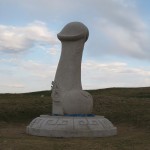Neo-Paganism is a nature religion which, like other nature religions, perceives nature as both sacred and interconnected. From this perspective, humans in the developed world have become tragically disconnected from nature, which has been desacralized in both thought and deed. Healing this rift is possible only through a profound shift in our collective consciousness. This constellation of ideas can be called “Deep Ecology”. This is the first in a 5-part series about some of “fruits” of Deep Ecology. This essay was originally published at Neo-Paganism.com.

The principle of interconnectedness refers to the concept that all living beings exist in relation to all other living beings. Our very being is determined by our ecology, by the material and cultural environment which we share with all other living beings. We are immersed in a web of life which is our true community. This is similar to the Buddhist concept of “dependent co-arising” discussed by Joanna Macy.
Take a look at a tree. Physically you are connected to the tree by the reciprocal flow of gasses, oxygen and carbon dioxide. As you breathe in, the tree breathes out; as you breathe out, the tree breathes in. The water flowing through the tree may soon flow through your body. Indeed, the very matter of what you are made was probably part of another tree long ago and will become part of yet another tree some day in the future.
Moreover, as David Abram explains, the very act of perceiving the tree, touching the tree, these are reciprocal encounters with a dynamic presence: “There is an intimate reciprocity to the senses; as we touch the bark of a tree, we feel the tree touching us,” writes Abram, “as we lend our ears to the local sounds and ally our nose to the seasonal scents, the terrain gradually tunes us in turn.” It is only by forgetting this sensuous involvement with the world that we are able to define the tree as an object from which we are separate.
In 1985, the Covenant of Unitarian Universalist Pagans (CUUPS) was organized as an independent affiliate of the Unitarian Universalist Association and the UUA adopted a Seventh Principle: “Respect for the interdependent web of all existence of which we are a part.” This change reflected the influence of Pagan membership in the UUA, which had previously been predominately humanist.
T. Thorn Coyle has suggests that whatever individual Pagans believe about the gods, whether or not they practice magic(k), and so on, Pagans are “concerned with the primacy of direct connection and relationship.” Similarly, Michael York defines paganism as “an affirmation of interactive and polymorphic sacred relationship by individual or community with the tangible, sentient and/or nonempirical.” The key word there is “relationship”. Along these same lines, in their survey of religious and spiritual groups in America, Robert Ellwood and Harry Partin write, “The unifying theme among the diverse Neo-Pagan traditions is the ecology of one’s relation to nature and to the various parts of one’s self.” Relationship is central to Neo-Pagan spirituality: relationship to the earth generally, to our local bioregions, to the other-than-human inhabitants of the earth, to one another, and to the many parts of our selves.
There is a tendency among Neo-Pagans to define themselves in contrast to the monotheistic faiths, especially Christianity. One of the most common distinctions drawn by Neo-Pagans is that they do not believe in “original sin.” Of course, there are many Christians who do not believe in original sin either. But Neo-Paganism’s rejection of the doctrine of the depravity of humankind is about more than a belief in the inherent goodness of all people. The story of the “fall” of humankind (and their subsequent redemption) is at the center of the Christian mythos. It is at its heart a story of alienation, followed by reconciliation through the Christian experience. Christian experience begins with separation, separation from God, but also from nature, from ourselves, and from other people. As God is separated from human kind, so humans are separated from the earth and nature, so our spirits are separated from our physical bodies, so our Descartian conscious minds are separated from our emotions and deeper non-rational selves, and so we are separated from one another. In this way, the Christian myth of the fall permeates the modern conception of self and world, whether or not we are Christian.
Neo-Paganism represents a challenge to this paradigm. Neo-Pagan experience is not one of separation, but of relationship, or rather “relatedness” or connection. As T. Thorn Coyle explains, “Our souls are connected to our bodies, our bodies are connected to this earth, this earth is connected to the cosmos, the cosmos is part of some larger flow of space, time, non-space, and non-time.” Thealogically, this experience translates into a pantheistic understanding of divinity. As Michael York explains, “even though such world religions as Christianity and Islam might cherish nature as a divine gift, they do not comprise nature religions. Instead, I argue that any religious perspective that honors the natural as the sacred itself made tangible, as immanent holiness, is pagan.”
Neo-Pagans recognize the modern experience of alienation, a sense of “rootlessness” or “homelessness” in our own world and in own bodies. But, for Neo-Pagans, this is not our natural condition. It is a symptom of modernity. It is manifest in social injustice, patriarchy, and neurosis. Neo-Paganism seeks to remedy this alienation by a return to or a reconnection with the imminent divine in the material world. This reconnecting is what many Neo-Pagans call the “re-enchantment of the world”.















